#Indian Film Project
Explore tagged Tumblr posts
Text
in honour of jgl coming to india, here’s Tom Hansen dancing to chaleya
10 notes
·
View notes
Text
The Impact of Colorism on Women of Color
Ronald E. Hall Conference on Colorism Presents The Impact of Colorism on Women of Color August 23, 2024 at 4:00 pm CST Join Dr. Donnamaria Culbreth, Dr. Lena Sharda, Ms. Simran Anjari and Ms. Ruchi Gali for a fireside chat focusing on the impact of colorism on women of color. Topics include lived experiences, the…

View On WordPress
#Asian women and colorism#Black women and colorism#Colorism#colorism and discrimination#colorism and healthcare#Colorism and Mental Health#colorism and self-love#colorism and socioeconomic status#colorism in film#colorism in the workplace#colorism project#Colorism project and women of color#dark skin#Dr. Lena Sharda#education and colorism#Inc.#Indian women and colorism#Latino women and colorism#light skin#media#Ms. Ruchi Gali#Ms. Simran Anjari#phenotypes and colorism#relationships and colorism#self-esteem and colorism#women of color and colorism
0 notes
Text
Akshay Kumar, Boney Kapoor’s firms and T-Series qualify for final round of bid for the development of Film City near Noida; Boney Kapoor’s Bayview wins bid
On January 18, Bollywood Hungama reported that as per The Economic Times, Akshay Kumar’s Cape of Good Films LLP, T-Series, Maddock Films, Boney Kapoor’s Bayview Projects LLP and K C Bokadia’s Lions Films Private Limited have submitted bids for the development of phase-1 of the Film City. The bids were submitted after the Yamuna Expressway Industrial Development Authority (YEIDA)’s invitation. Meanwhile, another article, published in the Times of India stated that Maddock Films, Cape of Good Films LLP, and others have formed a consortium, Supersonic Technobuild Private Limited, to execute the project.

There was a fresh update on this front very recently. It has come to light that Boney Kapoor’s Bayview Projects LLP emerged as the highest bidder for the ambitious project. The company, as per reports, is a joint venture between Boney Kapoor, Parmesh Construction Company Limited (Bhutani Group) and Noida Cyberpark Private Limited.
Some days ago, a report in The Indian Express stated that on Saturday, January 27, Bayview Projects LLP, Lions Films Private Limited, Supersonic Technobuild Private Limited and T-Series made presentations for the project and were technically qualified for the final stage of the selection process. As per YEIDA, the companies specially focussed on their vision for the Film City, concept, timeline for the completion of the project etc.
Pictures on the internet show Boney Kapoor present at the meeting while Akshay Kumar was a part of it virtually.
Another article in The Indian Express stated that Bayview Projects LLP agreed to provide YEIDA with an 18% gross revenue share, which was the highest offer among all the bidders. Lions Films Private Limited offered a gross revenue share of 15.12% while Supersonic Technobuild Private Limited and T-Series offered a revenue share of 10.80% and 5.27% respectively.
The Film City, which will entail an investment of Rs. 10,000 crores, will be constructed on a land of 1,000 acres and the first phase comprises 230 acres. The 1,000-acre site includes 740 acres for filming, 40 acres for film institutes, 120 acres for an amusement park and retail, and the balance 100 acres for commercial use. It also mentions that media industry offices, theme park, hotel, retail stores and an F&B hub will also be housed in the Film City.
Rajiv Arora, general manager and chief financial officer of Boney Kapoor’s firm Bayview, was quoted in an article in the Hindustan Times saying, “We will start work at the site as soon as the government hands over the 230 acres. We have already prepared our detailed strategy. We will invest Rs. 1,500 crores in this project and develop it in a manner so that we can provide everything related to films like artists, technology and studios. One can make an entire film under one roof with ease here once it is developed.”
#Akshay Kumar#Bayview Projects LLP#Boney Kapoor#Cape of Good Films LLP#Lions Films Private Limited#Maddock Films#News#Rajiv Arora#T-Series#The Film City#The Indian Express#YEIDA#bollywood hungama
0 notes
Text
"When a severe water shortage hit the Indian city of Kozhikode in the state of Kerala, a group of engineers turned to science fiction to keep the taps running.
Like everyone else in the city, engineering student Swapnil Shrivastav received a ration of two buckets of water a day collected from India’s arsenal of small water towers.
It was a ‘watershed’ moment for Shrivastav, who according to the BBC had won a student competition four years earlier on the subject of tackling water scarcity, and armed with a hypothetical template from the original Star Wars films, Shrivastav and two partners set to work harvesting water from the humid air.
“One element of inspiration was from Star Wars where there’s an air-to-water device. I thought why don’t we give it a try? It was more of a curiosity project,” he told the BBC.
According to ‘Wookiepedia’ a ‘moisture vaporator’ is a device used on moisture farms to capture water from a dry planet’s atmosphere, like Tatooine, where protagonist Luke Skywalker grew up.
This fictional device functions according to Star Wars lore by coaxing moisture from the air by means of refrigerated condensers, which generate low-energy ionization fields. Captured water is then pumped or gravity-directed into a storage cistern that adjusts its pH levels. Vaporators are capable of collecting 1.5 liters of water per day.

Pictured: Moisture vaporators on the largely abandoned Star Wars film set of Mos Espa, in Tunisia
If science fiction authors could come up with the particulars of such a device, Shrivastav must have felt his had a good chance of succeeding. He and colleagues Govinda Balaji and Venkatesh Raja founded Uravu Labs, a Bangalore-based startup in 2019.
Their initial offering is a machine that converts air to water using a liquid desiccant. Absorbing moisture from the air, sunlight or renewable energy heats the desiccant to around 100°F which releases the captured moisture into a chamber where it’s condensed into drinking water.
The whole process takes 12 hours but can produce a staggering 2,000 liters, or about 500 gallons of drinking-quality water per day. [Note: that IS staggering! That's huge!!] Uravu has since had to adjust course due to the cost of manufacturing and running the machines—it’s just too high for civic use with current materials technology.
“We had to shift to commercial consumption applications as they were ready to pay us and it’s a sustainability driver for them,” Shrivastav explained. This pivot has so far been enough to keep the start-up afloat, and they produce water for 40 different hospitality clients.
Looking ahead, Shrivastav, Raja, and Balaji are planning to investigate whether the desiccant can be made more efficient; can it work at a lower temperature to reduce running costs, or is there another material altogether that might prove more cost-effective?
They’re also looking at running their device attached to data centers in a pilot project that would see them utilize the waste heat coming off the centers to heat the desiccant."
-via Good News Network, May 30, 2024
#water#india#kerala#Kozhikode#science and technology#clean water#water access#drinking water#drought#climate change#climate crisis#climate action#climate adaptation#green tech#sustainability#water shortage#good news#hope#star wars#tatooine
1K notes
·
View notes
Text
KASHMIR MASTERLIST
Background
History of Kashmir from 250 BC to 1947 [to understand Kashmir's multi religious history and how we got to 1947]
Broad timeline of events from 1947 to the abrogation of Article 370 of the Indian Constitution in 2019 (BBC) [yes, BBC. hang on just this once]
Human Rights Watch report based on a visit to Indian controlled Kashmir in 1998 [has a summary, background, human rights abuses and recommendations]
Another concise summary of the issue
Sites to check out
Kashmir Action - news and readings
The Kashmiriyat - independent news site about ongoings in Kashmir
FreePressKashmir - same thing as previous
Kashmir Law and Justice Project - analysis of international law as it applies to Kashmir
Stand with Kashmir - awareness, run by diaspora Kashmiris (both Pandit and Muslim)
These two for more readings and resources on Kashmir: note that the petitions and donation links are from 2019 and also has explainers on the background (x) (x)
To read
Do You Remember Kunan Poshpora? - about women in the Kashmiri resistance movement and the 1991 mass rape of Kashmiri women in the twin villages of Kunan and Poshpora by Indian armed forces
Until My Freedom Has Come: The New Intifada in Kashmir - a compliation of writings about the lives of Kashmiris under Indian domination
Colonizing Kashmir: State Building under Indian Occupation - how Kashmir was made "integral" to the Indian state and examines state-building policies (excerpt)
Resisting Occupation in Kashmir - about the social and legal dimensions of India's occupation
On India's scapegoating of Kashmiri Pandits, both by Kashmiri Pandits (x) (x)
Of Gardens and Graves - translations of Kashmiri poems
Social media
kashiirkoor
museumofkashmir
kashmirpopart
posh_baahar
readingkashmir
standwithkashmir and their backup account standwithkashmir2 (main account is banned in India wonder why)
kashmirlawjustice
kashmirawareness
jammugenocide (awareness about the 1947 genocide abetted by Maharaja Hari Singh and the RSS)
To watch
Jashn-e-Azadi: How We Celebrate Freedom parts 1 and 2 - a documentary about the Kashmiri freedom struggle (filmed by a Kashmiri Pandit)
Paradise Lost - BBC documentary about how India and Pakistan's dispute over the valley has affected the people
Kashmir - Valley of Tears - the exhaustion with the conflict in the post nineties
In the Shade of Fallen Chinar - art as a form of Kashmiri resistance
Human rights violations (x) (x) (x) (x) (x)
Land theft and dispossession (x) (x) (x) (x) (x) (x)
A note: I know annoying Desis are going to see this and go "Oh but Kashmir is Pakistan's because-" and "Kashmir is an integral part of India because-". I must make my stance clear: Kashmir belongs to the Kashmiris, the natives, no matter what religion they belong to. Neither Pakistan nor India get to decide the matter of Kashmiri sovereignty. The reasons given by both parties as to why Kashmir should be a part of either nation are bullshit. The United Nations itself recognises Kashmir as a disputed region, so I will not entertain dumbfuckery. I highly encourage fellow Indians especially to take the time to go through and properly understand the violence the government enacts on Kashmiris. I've also included links to learn more about Kashmiri culture because really, what do the rest of us know about it? Culturally and linguistically Kashmir differs so much from the rest of India and Pakistan (also the amount of fetishization of Kashmiri women...yikes). This is not just a bilateral issue between these two nations over land, this actually affects the people of Kashmir. And if you're still here, thank you for reading
#this took a month of my life i'm not even kidding#ANYWAYS. hi. here you go.#kashmir#india#resources#important#history
1K notes
·
View notes
Note
Hey there, quick question. Do you have any suggestions on good, accurate sources for native American names? I'm writing a story and one of the characters friends is native, they live in Jersey. I have been trying to find Lanape names that fit her and are also actaully of the langauge and cultural background. Everytime I search though it's few and far between. Any resources if you have any would be appreciated, if not, sorry for the bother! Thank you
There is not a magical source for "accurate" NAMES, CLOTHES, OR CULTURAL PRACTICES!!!/

Even if there was I wouldn’t share it, naming conventions are totally different than English ones! Firstly you can’t have a name someone else has unless they give permission, and another thing don’t go around using irl people’s names and last names that’s crazy. Another thing how do I know anything about lanape people? I’m a plains Indian 😭I have no idea what the naming conventions are over there. I hope the other people asking for convenient sources see this because no researching is not convenient even for me.
How people would do this irl for films and book they hire a cultural consultant. That cultural consultant goes on to ask elders for names or firstly permission for the tribe to be even in these movies and books. A lot of this stuff is PROTECTED LAWFULLY. Like if someone wanted to they could totally sue you for misrepresenting their tribe it’s just like a lot of money and hard to prove for damages, and the whole tribe has to vote on it.
I’m very excited you are interested in indigenous people but I can’t say the same for your projects and having to holding your hand through it to get it right. I might as well write my own story, world, and characters at that point. 😭
401 notes
·
View notes
Text

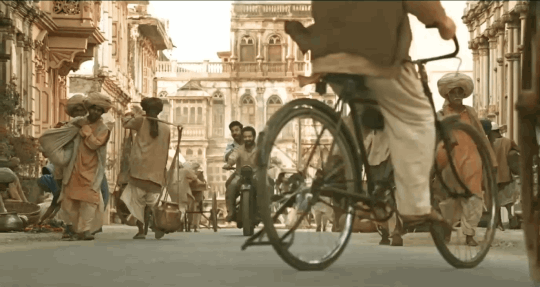


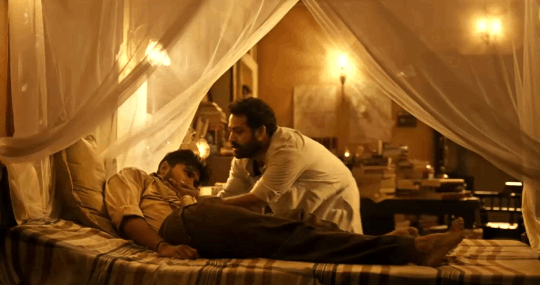
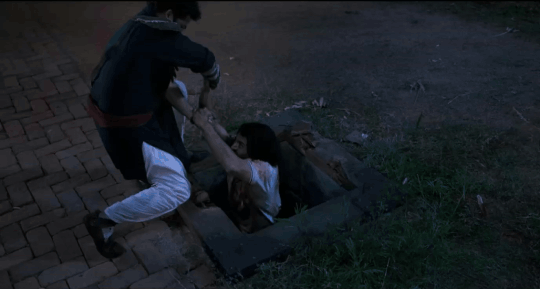
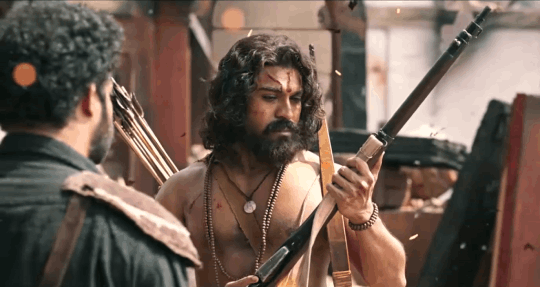

Queerness in Indian Media
↳Film: RRR (2022, Telugu), dir. S.S. RAJAMOULI
RRR is a historical fantasy action drama that follows Bheem (NTR Jr), a Gond warrior who is in search of a Gond girl who was taken away from their home, and Ram (Ram Charan), the British Army officer assigned to catch him. Ram and Bheem meet under false identities and quickly grow closer, but everything is thrown into chaos once the truth is revealed and Ram is forced to choose between his ambitions and his attachment to Bheem.
Long before any white person had ever heard of RRR, queer Indians were cautiously optimistic that there would be something for us in this movie. There was the song Dosti, which felt more romantic than the average song about friendship; Bheem's intense declaration toward Ram in the trailer; Rajamouli explaining that there is no boy-girl romantic song (a staple of masala Indian cinema in any language) because "the romance angle is between these two guys only...bromance...they are the heroes, they are the hero and heroine, and they are the hero and villain"; the lead actors repeatedly questioning interviewers who referred to Jenny and Seetha as Bheem and Ram's love interests; and the writer, V. Vijayendra Prasad, being a huge fan of Salim-Javed movies, particularly Sholay, whose homosocial pairing has been read as queer by queer Indians for decades.
The movie itself gave us more than we could have hoped for from a project made on such a huge scale. Ram and Bheem mimic many of the "hero and heroine" pairings in so many masala movies, doing everything from the "slow-mo staring" for the first meeting, to getting a whole montage song for the progression of their bond, to dressing each other up, to dancing together at a party, to carrying each other, to rescuing each other.
The final rescue scene is perhaps the most telling, as it twists a well-known myth from the Ramayana by putting Ram and Bheem in the position of heroine and hero. It is not Hanuman who tells Rama where to find Sita in Lanka, but instead Seetha who tells Bheem where to find Ram. Bheem, upon finding him, promises to get him out 'even if [he has] to burn this Lanka down to do it'--then promptly carries him on his shoulders the way Hanuman carried Rama, to do away with any suspicions from homophobic audiences.
Those homophobic audiences still made their complaints--a glance at the oldest comments on any clip or behind the scenes video for RRR will make that clear--but they were drowned out by the many fans of the movie. Ultimately, like with any coded movie, the interpretation is up to the individual, but it is undeniable that a number of queer Indians felt that there was a romantic bond between Ram and Bheem. To dismiss that would do a disservice to the many queer people who have, are, and always will work quietly behind the scenes to write our stories, even if they can never say so directly.
#rrr#tollywood#rambheem#this was the hardest post to make simply bc every time I talk about rrr I feel very#'this article contains excessive information' dot wikipedia warning.#thank you to my beloved ivy who has heard all my Excessive Information. ur a real one.#anyway I really had to restrain myself with this one and still it is the longest post for this series. rip.#anyway. wanted to do this one before pride month ends and before I take a break from this series#to make other gifs for a while bc quite frankly these take a long time to put together and I need. a break.#queerness in indian media#long post
899 notes
·
View notes
Text
All the Films in Competition at Cannes, Ranked from Best to Worst
The twenty-two films that premièred in the 2024 festival’s main program offered much to savor and revile.
By Justin Chang May 26, 2024
The seventy-seventh annual Cannes Film Festival came to a startling and joyous conclusion on Saturday night, when the competition jury, chaired by Greta Gerwig, awarded the Palme d’Or, the festival’s highest honor, to “Anora,” a funny, harrowing, and finally quite moving portrait of a sex worker’s madcap New York misadventures. It was startling because the movie, though one of the best-received in the competition, had not been widely tipped for the top prize, which seldom goes to a U.S. film; with “Anora,” Sean Baker becomes the first American director to win the Palme since Terrence Malick did, for “The Tree of Life” (2011), thirteen years ago. And it was joyous not only because the award was bestowed on a worthy and remarkable film but because Baker used the occasion to deliver the best, most eloquent and impassioned acceptance speech I’ve ever heard a Palme winner give.
Reading from prepared remarks, Baker singled out two other filmmakers in the competition, Francis Ford Coppola and David Cronenberg, as among his personal heroes. He dedicated the award to sex workers everywhere, a fitting tribute from a filmmaker who has put their lives front and center, with drama, humor, and empathy, in movies like “Starlet” (2012), “Tangerine” (2015), and “Red Rocket” (2021). He tossed some exquisite shade in the direction of the “tech companies” behind the so-called streaming revolution—including, presumably, Netflix, which came away as one of the night’s big winners; its major acquisition of the festival, Jacques Audiard’s musical “Emilia Pérez,” won two prizes. And, in a moment that drew rapturous applause, Baker delivered a plea on behalf of theatrical films, declaring, “The future of cinema is where it started: in a movie theatre.”
I was fortunate to see all twenty-two films in the Cannes competition on the big screen, projected under superior conditions in houses packed with fellow movie lovers. It’s my hope that, when these movies are released in the U.S., as the great majority of them likely will be, you will seize the chance to see them on the big screen as well—even “Emilia Pérez,” which Netflix may not keep in theatres for long, but whose bold dramatic and stylistic risks have the best chance of winning you over if they have your undivided, wide-awake attention.
I have ranked the movies in order of preference, from best to worst. Here they are:
1. “Caught by the Tides”

Jia Zhangke, a Cannes competition veteran, has long been the cinema’s preëminent chronicler of modern China (“Mountains May Depart,” “Ash Is Purest White”), mapping its social, cultural, and geographical complexities with great formal acumen, and also with the longtime collaboration of his wife, the superb actress Zhao Tao. Jia’s latest work, drawing on an archive of footage shot in the course of roughly two decades, unfurls a story in fragments, about a woman (Zhao) and a man (Li Zhubin) who fall in love, bitterly separate, and have a melancholy reunion years later. It’s an achievement by turns fleeting and monumental: a series of interlocking time capsules, a wrenching feat of self-reflection, and a stealth musical, in which Zhao dances and dances, standing in for millions who have learned to sway and bend to history’s tumultuous beat.
2. “All We Imagine as Light”
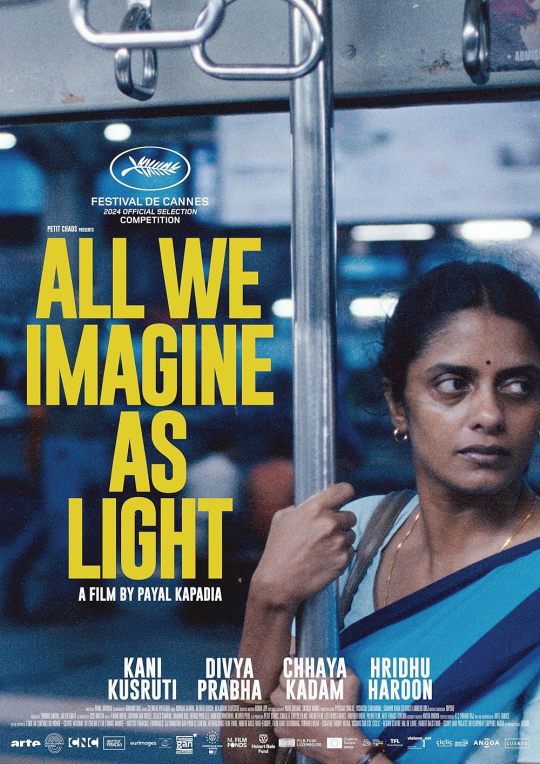
As the first Indian feature invited to compete at Cannes in nearly three decades, Payal Kapadia’s narrative début (after her 2021 documentary, “A Night of Knowing Nothing”) would be notable enough; that the movie is so delicately felt and sensuously textured is cause for outright celebration. Winner of the festival’s Grand Prix, or second place, it tells the story of two roommates, Prabha (Kani Kusruti) and Anu (Divya Prabha), who work as nurses at a Mumbai hospital. It teases out their personal circumstances—Prabha’s estrangement from her unseen husband, Anu’s frowned-upon romance with a young Muslim man (Hridhu Haroon)—with a quiet truthfulness that, like the glittering lights of the city, lingers expansively in the memory. (A forthcoming Sideshow/Janus Films release.)
3. “Grand Tour”

The Portuguese director Miguel Gomes (“Tabu,” “Arabian Nights”) delivered some of the most virtuosic filmmaking in the competition—as the jury recognized by giving him the Best Director prize—with this characteristically yet extraordinarily playful colonial-era travelogue. Shifting between color and black-and-white, set in 1917 but full of fourth-wall-breaking anachronisms, the movie tells a story of sorts about a roving British diplomat (Gonçalo Waddington) and a fiancée (Crista Alfaiate) he’s in no hurry to marry. But its true fascination lies in the humid atmosphere and wanderlust-inspiring splendor of its East and Southeast Asian locations, ranging from Singapore and Bangkok to Shanghai and Rangoon. It’s a movie to get lost in.
4. “The Seed of the Sacred Fig”
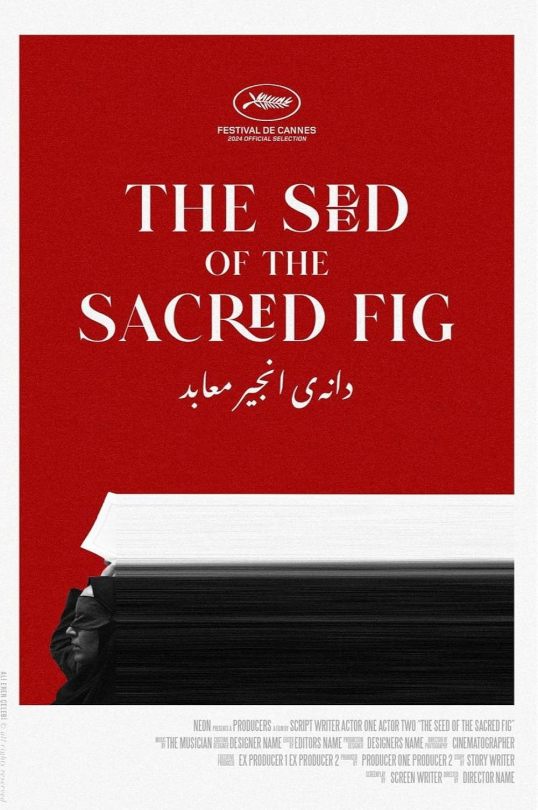
It’s impossible to absorb this blistering domestic drama without thinking of its dissident director, Mohammad Rasoulof, who recently fled Iran after being sentenced to prison and a flogging. (His appearance at his film’s première made for one of the most emotional moments in recent Cannes memory.) Shot entirely in secret, the story follows a Tehran-based husband (Missagh Zareh) and wife (Soheila Golestani) who are increasingly at war with their progressive-minded young-adult daughters (Mahsa Rostami, Setareh Maleki) during nationwide political protests led by women. The result is a thriller of propulsive skill and blunt emotional force, marrying the muscularity of an action film to the psychological intensity of a chamber drama. (A forthcoming Neon release.)
5. “Anora”

The director Sean Baker is near the height of his storytelling powers with this dazzling (and now Palme d’Or-winning) portrait of a Manhattan strip-club dancer (a revelatory Mikey Madison) who impulsively marries the ultra-spoiled son (Mark Eydelshteyn) of a Russian oligarch. Much comic chaos ensues, some of it pushed past the brink of plausibility, but Baker’s multifaceted love for his characters proves infectious and sustaining, as does his belief that acts of unexpected kindness can redeem even the darkest nights of the soul. (A forthcoming Neon release.)
6. “The Shrouds”

Early on in this elegantly sombre yet mordantly funny new movie, which stars Vincent Cassel, Diane Kruger, and Guy Pearce, the director David Cronenberg, a master of cerebral horror, unveils his latest invention: a technologically advanced burial shroud that allows people to watch a loved one’s body decomposing in the grave. So begins a drolly fluid inspection of classic Cronenberg themes—the deterioration of the flesh, the instability of the image, the paranoia-inducing incursions of technology into every aspect of life—but imbued with a nakedly personal dimension that the director has noted in interviews; the story was inspired by his wife’s death, in 2017, from cancer.
7. “Megalopolis”
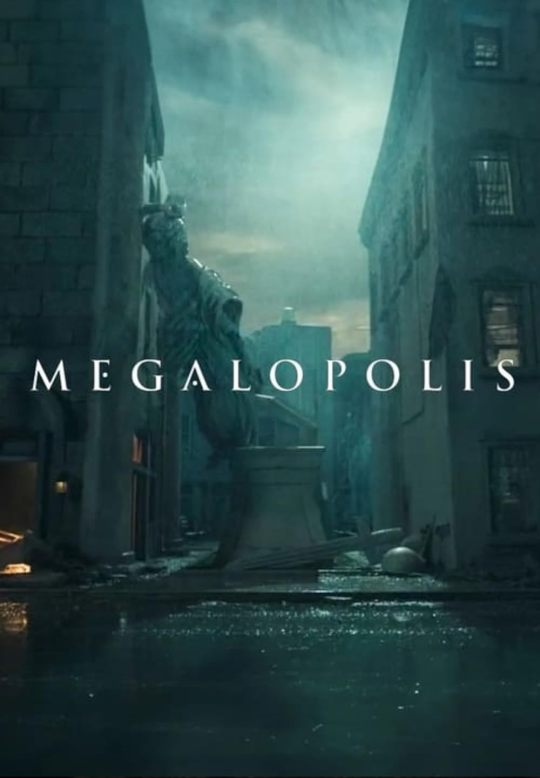
In this legendarily long-gestating passion project, which I’ve written about at length, Francis Ford Coppola posits that our fragile, battered civilization is headed the way of the Roman Empire. The grimness of that prospect is unsurprising from a director accustomed to peering deep into the heart of American darkness (the “Godfather” movies, “The Conversation,” “Apocalypse Now”). For all that, the filmmaking here glows with a particularly hard-won optimism, even a welcome sense of play—borne out by an ensemble of actors, including Adam Driver, Giancarlo Esposito, and especially Aubrey Plaza, who fully embrace Coppola’s rhetorical and conceptual flights of fancy.
8. “The Substance”
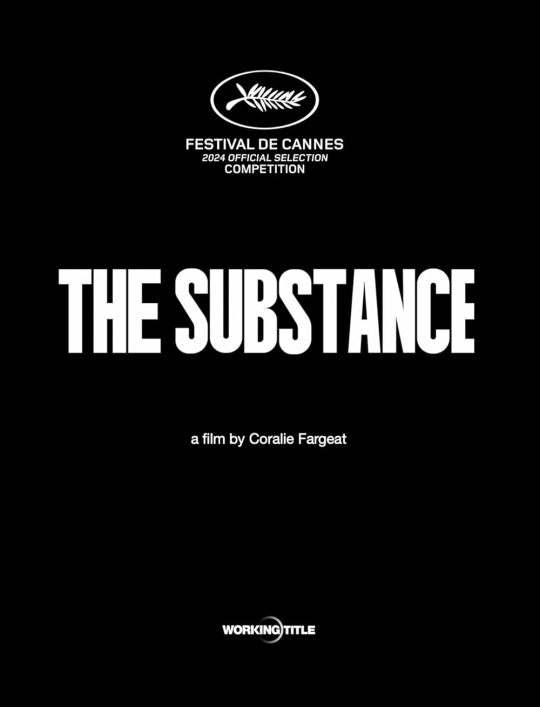
Sympathetic or sadistic? Feminist or misogynist? Coralie Fargeat’s body-horror bonanza, which won the festival’s award for Best Screenplay, has been one of the competition’s more polarizing hits, which is unsurprising; divisiveness should be expected from a story about an aging actress and TV fitness guru who, desperate to regain her youthful bod of yesteryear, effectively splits herself in two. Whether the outlandish premise (think “The Picture of Dorian Gray” by way of “Death Becomes Her”) and its blood-gushing fallout withstand intellectual scrutiny, there’s no doubting the ferocity of the two leads, Demi Moore and Margaret Qualley, or Fargeat’s sheer filmmaking verve as she pushes her ideas to their sanguinary conclusions.
9. “Motel Destino”

Just a year after the Brazilian director Karim Aïnouz appeared in competition with a surprisingly stiff-corseted English period drama, “Firebrand,” it was bracing to watch him rebound with the competition’s most sexually uninhibited and flagrantly horny title; corsets don’t apply here, and even underwear proves blissfully optional. Set at a seedy roadside motel where the clientele never stops moaning, it’s a feverishly shambling erotic thriller starring three very game actors (Iago Xavier, Nataly Rocha, and Fábio Assunção) in a romantic triangle that plays like James M. Cain with sex toys—“The Postman Always Cock Rings Twice,” as it were.
10. “Emilia Pérez”

A trans-empowerment musical set against the backdrop of Mexico’s drug cartels might sound like a dubious proposition on paper, and, for the many detractors of this genre-melding big swing from the French director Jacques Audiard (“A Prophet,” “The Sisters Brothers”), what actually made it onto the screen was no better. But I was disarmed from the start by Audiard’s quasi-Almodóvarian vibes, his touchingly imperfect embrace of song-and-dance stylization, and, most of all, his three leads: the remarkable discovery Karla Sofía Gascón, a scene-stealing Selena Gomez, and a never-better Zoe Saldaña. All three (along with Adriana Paz) were recognized with the festival’s Best Actress prize, awarded collectively to the movie’s ensemble of actresses; Audiard also won the Jury Prize. (A forthcoming Netflix release.)
11. “Oh, Canada”

After a tense trilogy of dramas about male redemption through violence (“First Reformed,” “The Card Counter,” “Master Gardener”), the writer and director Paul Schrader has taken a gentler turn with an adaptation of “Foregone,” a 2021 novel by the late Russell Banks. (It’s his second Banks adaptation, after the 1997 drama “Affliction.”) In exploring the fragmented consciousness of an aging documentary filmmaker (played at different ages by Richard Gere and Jacob Elordi), Schrader bravely forsakes the narrative fastidiousness of his recent work and takes on grand themes of memory, mortality, and artistic self-reckoning, to formally ragged but sincerely moving effect.
12. “The Girl with the Needle”

This stark and terrifying black-and-white drama from the Swedish-born, Polish-based director Magnus von Horn (“Sweat”) was perhaps the competition’s bleakest entry. Set in Copenhagen immediately after the First World War, it pins us so mercilessly to the hard-bitten perspective of Karoline (an excellent Vic Carmen Sonne), a factory seamstress who becomes pregnant out of wedlock, that we scarcely notice her story shifting in a different, more sinister direction. It’s a bitterly hard-to-stomach brew of a movie, at once hideous and beautifully made, with a chilling supporting turn by Trine Dyrholm as a friend whose interventions turn out to be anything but benign.
13. “Three Kilometres to the End of the World”
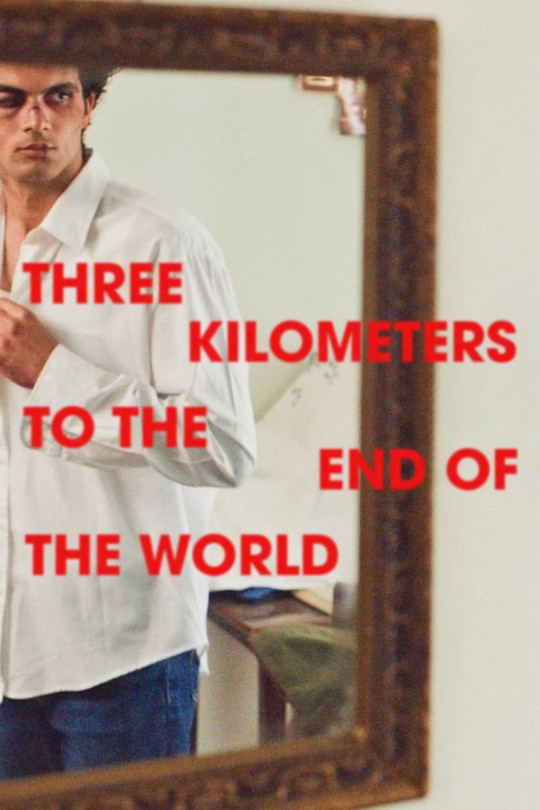
The setting of this well-observed but emotionally opaque drama, from the Romanian actor turned director Emanuel Pârvu, is a small rural village where a closeted teen-age boy, Adi (Ciprian Chiujdea), is brutally beaten after being caught in an intimate moment with a male traveller. Pârvu teases out the legal, psychological, and moral fallout with the pitch-perfect performances and laserlike formal focus that have become hallmarks of new Romanian cinema. But, though the movie is persuasive enough as an indictment of small-town religious fundamentalism and homophobia, it proves curiously incurious about Adi’s perspective, to the detriment of its own human pulse.
14. “Kinds of Kindness”

After his Oscar-winning period romps “The Favourite” (2018) and “Poor Things” (2023), the Greek director Yorgos Lanthimos scales back—but goes long—with a sprawling, increasingly tedious compendium of comic cruelty. My favorite of the film’s three disconnected stories, all featuring the same actors, is the one where Jesse Plemons (the ensemble M.V.P., as the jury recognized with its Best Actor award) plays Willem Dafoe’s Manchurian candidate; my least favorite is the one where Emma Stone joins a sweat-worshipping sex cult. The one where Stone slices off her finger and cooks it for Plemons falls—much like the movie in Lanthimos’s over-all œuvre—somewhere in the middle. (A Searchlight Pictures release, opening June 21st in theatres.)
15. “Bird”

My admiration for the English filmmaker Andrea Arnold (“American Honey”) is such that I’m eager to revisit her latest rough-and-tumble coming-of-age story and find that I undervalued it. Arnold is certainly skilled at integrating recognizable actors, which in this case includes Barry Keoghan and Franz Rogowski, into her grottily realist frames, and she has an appealing lead performer in Nykiya Adams, as a twelve-year-old girl who overcomes persistent abuse and neglect. But the story may lose you—as it lost me—with a magical-realist turn that magnifies, rather than minimizes, the tortured-animal symbolism that has often dogged Arnold’s work.
16. “Beating Hearts”

An exchange of insults at a high-school bus stop provides a saucy meet-cute for a good girl (Mallory Wanecque) and a ne’er-do-well boy (Malik Frikah); so begins a raucous and endearing love story for the ages, in which the director Gilles Lellouche, with outsized glee and little discipline, merrily appropriates the conventions of classic Hollywood musicals and gangster flicks. The result is much too long at nearly three hours—the story spans several years, with Adèle Exarchopoulos and François Civil playing older versions of the two leads—but I can’t say I didn’t warm to its rambunctious cornball charm.
17. “Limonov: The Ballad”

Why make a film about Eduard Limonov, the globe-trotting Russian dissident poet and punk provocateur reviled for his pro-fascist sympathies? The filmmaker Kirill Serebrennikov never musters a satisfying answer in this muddled English-language bio-pic, despite an energetically uninhibited central performance by Ben Whishaw and a cheeky panoply of filmmaking techniques—jittery camerawork, lengthy tracking shots—meant to catch us up in the épater-la-bourgeoisie exuberance of Limonov’s revolt. Considering his earlier work, I prefer the rebel-youth vibes of “Leto” (2018) and the dazzling cinematic assaults of “Petrov’s Flu” (2021), both of which also screened in competition here.
18. “Parthenope”

Nearly every new picture from the Italian auteur Paolo Sorrentino could be reasonably called “The Great Beauty,” the title of his gorgeous 2013 cinematic tour of Rome. (It left that year’s Cannes empty-handed, but won the Oscar for Best Foreign Language Film.) His latest work remains most intriguing for its ambivalent but still sensually overpowering vision of the director’s home town, Naples, from which springs a modern-day goddess, named after Parthenope, a Siren from Greek mythology. She’s played by Celeste Dalla Porta, a great beauty indeed and an empathetic screen presence, though only fitfully does her character seem worthy of this movie’s epic enshrinement.
19. “Wild Diamond”

Another disquisition on beauty and its discontents, this time from the débuting French writer and director Agathe Riedinger. She hurls us the life and busy social-media feed of a nineteen-year-old, Liane (a terrific Malou Khebizi), who has nipped, tucked, and tailored every part of herself to realize her dream of being selected for a hot new reality-TV series. Part influencer-culture cautionary tale, part bad-girl Cinderella story, the movie glancingly suggests the soul-rotting effects of beauty worship, but it falls victim to the trap that Liane is trying to avoid: in a sea of worthy candidates, it doesn’t especially stand out.
20. “The Apprentice”
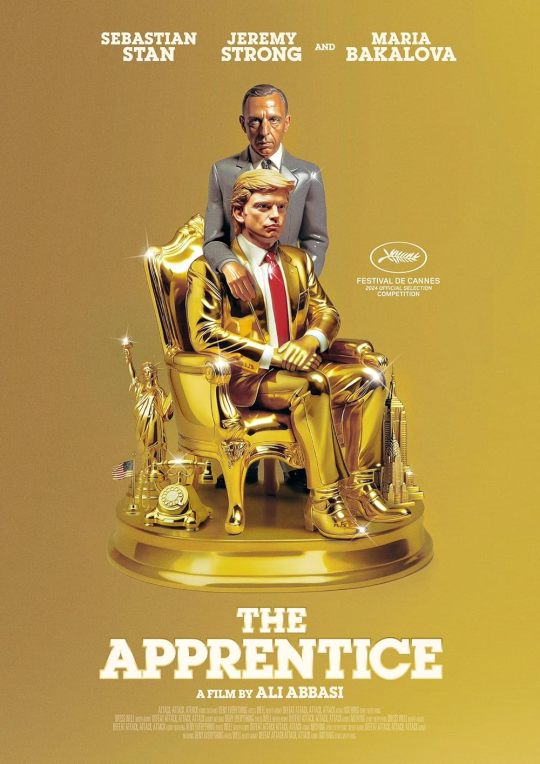
Donald Trump’s attorneys have threatened legal action to block the release of this drama about his early rise to fame and wealth under the mentorship of the attorney Roy Cohn (Jeremy Strong). It speaks to the useless proficiency of Ali Abbasi’s movie that the prospect of such censorship provokes more indifference than outrage. Shot to evoke cruddy nineteen-eighties VHS playback, the movie is well acted by Strong, Maria Bakalova as Ivana Trump, and an increasingly makeup-buried Sebastian Stan as Trump himself, depicted from the start as a sack of shit that gets progressively shittier. It’s not dismissible, but it’s hardly the stuff of revelation, either.
21. “Marcello Mio”

In this trifling meta-comedy from the French filmmaker Christophe Honoré (previously in the 2018 Cannes competition with the lovely “Sorry Angel”), the actress Chiara Mastroianni embarks on a strainedly whimsical personal odyssey to examine the legacy of her late father, the legendary Italian actor Marcello Mastroianni, and her own conflicted place therein. To that end, she spends much of this overstretched movie in “8½” and “La Dolce Vita” black-suited drag as she navigates a roundelay of industry in-jokes; among the French cinema luminaries making appearances are Fabrice Luchini, Nicole Garcia, and, most welcome, Chiara’s mother, Catherine Deneuve.
22. “The Most Precious of Cargoes”

The French director Michel Hazanavicius continues his uneven post-“The Artist” run with this animated Second World War fable, adapted from a 2019 novel by Jean-Claude Grumberg (and narrated by the late Jean-Louis Trintignant). It has an affecting opening stretch, in which a baby girl, thrown by her desperate father from an Auschwitz-bound train, is rescued and raised in secret by a woodcutter’s kindhearted wife. But when the child’s provenance is discovered, stoking local antisemitism, the movie becomes a bathetic wallow in Holocaust imagery, drowned in an Alexandre Desplat score whose every surge turned my heart increasingly to stone. ♦
#Cannes Film Festival#Cannes Film Festival 2024#Youtube#Caught by the Tides#All We Imagine as Light#Grand Tour#The Seed of the Sacred Fig#Anora#The Shrouds#Megalopolis#The Substance#Motel Destino#Emilia Pérez#Oh Canada#The Girl with the Needle#Three Kilometres to the End of the World#Kinds of Kindness#Bird#Beating Hearts#Limonov: The Ballad#Parthenope#Wild Diamond#The Apprentice#Marcello Mio#The Most Precious of Cargoes
111 notes
·
View notes
Text
This article hits a lot of my discomfort around comparing the LTTE to Hamas, or any of the Palestinian resistance.
Do I believe in Tamil self-determination? Yes. Should they have a sovereign state? Yes. Should they have won the North instead of the SL military? Absolutely. Does any indigenous Tamil or Muslim person in the North and East have the right to armed resistance against majoritarian rule? Also yes. Was the LTTE rank and file fighters resisting annihilation and the SL military to a man was committing murder? Yes.
Do I believe the LTTE as an organisation and Prabhakaran as its head actually stood for anything but replacing the Sinhalese ethnostate with a Tamil one of their own choosing? Fucking no.
Navaratnam, after splitting away from the Federal Party, also published a newspaper, Viduthalai. I read the paper in the 1970s, when it often compared Tamils and Jews in terms of cultural character—including a supposed predisposition for intelligence and entrepreneurship—and argued that they were similar. (This line of thinking survives to this day: I know of Tamil nationalists in the diaspora who invoke the establishment of Israel as an example for their own goals, and see similarities in the Tamil and Jewish struggles.) Viduthalai also serialised Exodus, a popular 1958 novel by the American Jewish writer Leon Uris, which was translated by Navaratnam and published in Tamil as Namakkoru Naadu—A Country of Our Own.
Exodus presents a factually inaccurate but heroic account of the Zionist project to establish Israel as a Jewish nation state, and follows a group of Jewish arrivals in Palestine after the Second World War. It makes no mention of the mass dispossession and ethnic cleansing of Palestinians by Zionist forces in 1948. Edward Said, the Palestinian activist and intellectual, has highlighted how the novel dehumanises Arabs. Said has also argued that, when it comes to Israel, “the main narrative model that dominates American thinking still seems to be Leon Uris’ 1958 novel Exodus.” The British journalist Robert Fisk once described the novel as a “racist fictional account of the birth of Israel” in which Arabs are “rarely mentioned without the adjectives ‘dirty’ and ‘stinking’.”
Velupillai Prabhakaran, who established the LTTE in 1976, was a supporter of the Self-Rule Party as a young man. He would also have been a Viduthalai reader, and was inspired by Exodus. I was informed by a former LTTE member that the organisation also separately translated Exodus in full in the mid-1980s, and that it was widely distributed among LTTE cadres and supporters. Two prominent members of the organisation told me separately that the film adaptation of Exodus was also screened to LTTE cadres at camps in both Sri Lanka and the southern Indian state of Tamil Nadu.
Following long-term disillusionment with the LTTE, and seeing no democratic space to raise my concerns with the organisation’s autocratic leader, Prabhakaran, I quit the LTTE for good in April 1984. Many others also left, both before and after me, with the same concerns – among them the one-man leadership and complete intolerance for political discussion or difference. Some of them were murdered by the LTTE for leaving. One tragic example is Patkunam, one of the group’s founding members, who was murdered by Prabhakaran sometime in or around 1977 with the agreement of the appointed central committee of the LTTE. Prabhakaran suspected that Patkunam had been influenced by EROS’s leftist ideas and wanted to leave the LTTE. The LTTE had a policy that those who wanted to leave and join another group or establish another organisation would face capital punishment.
...
As it increasingly gained control of the North and East of Sri Lanka, the LTTE arbitrarily declared itself the “sole representative” of the Sri Lankan Tamil people. On this basis, it targeted Tamil activists from leftist and progressive organisations, killing or otherwise silencing them. The leadership of the TULF, the Tamil parliamentary party, was also wiped out. From as far back as the mid 1980s, the LTTE also suppressed other Tamil militant organisations such as TELO, PLOTE and the EPRLF. Eventually this meant targeted killings and massacres of both cadres and leaders from rival groups. Sections of EROS were forcibly absorbed into LTTE ranks. The LTTE also killed numerous EPRLF and PLOTE cadres who had received training from the PFLP in Syria.
...
In 1990, the LTTE executed a plan to ethnically cleanse Muslims from territories under its control in the North of Sri Lanka. The entire Muslim population of the Jaffna, Vavuniya, Mullaitivu, Mannar and Kilinochchi districts, numbering approximately 75,000 people, was evicted at gunpoint. This demonstrated the LTTE’s desire to establish an ethnically exclusive Tamil state, much like the Jewish state of Israel envisioned by the Zionists. The LTTE’s entire ideology was based on exclusive Tamil nationalism; its idea of a homeland and a nation meant treating Muslims and other minority communities in Tamil-dominated areas as second-class citizens at best. In this, it had uncomfortable similarities with the Zionist outlook on Palestinians and Muslims.
...
The LTTE was a right-wing organisation, with a statist approach to popular struggles. Prabhakaran made it clear that the LTTE would not interfere with “domestic issues” in other countries. I know this because, while I was with the organisation, he did not want to have any links with Marxist-Leninist parties in India as he did not want to antagonise the Indian state. The LTTE’s international network consistently aligned with Western governments and lobbied for their support. Although the LTTE was deemed a terrorist organisation and proscribed by the United States, the United Kingdom and the European Union, these governments’ notices stated clearly that the LTTE had no intention of targeting Western interests.
The LTTE leadership was a corrupt bunch of autocrats that ethnically cleansed and killed anyone that got in their way, including their own people, having solidarity with no one and led by a personality cult not so different from MR's. Nurturing Karuna and Pillayan at their breast while they massacred Muslims, conscripted children and killed and disappeared Tamil activists and journalists, and then crying foul when they defected to get away with their loot? Nah son. Just like the SL government, the LTTE didn't care what they were doing as long as they didn't do it to them. Because in their ego-driven ideology, Tamil self-determination began and ended with them. Even now, it continues to obstruct the Tamil struggle because, since the LTTE made itself and its own nationalist project the sole representative of Tamil freedom, their defeat in 2009 makes the Tamil resistance itself look like it's dead in the water. Tamil Eelam's generational legacy of varied ideologies, factions, alternative enterprises and coalitions that preceded them all erased by this one failed cadre.
Hamas is far from perfect, but there's a continuity to its evolution, a devolution of power within their ranks, a willingness to work as a coalition with other resistance groups, and a generational network of anti-imperialist, anti-colonial solidarity and diplomacy behind them. The LTTE was just cut from the same post-colonial ethnonationalist cloth as the Sinhalese majoritarian state. Freire spoke truly when he said that the oppressed see their model of manhood in their oppressor. As long as we continue to identify with the powerful instead of the powerless, we will never be anything but pawns in the imperial project of coloniality.
*I do wish the author hadn't just...glossed over the horror that was the Indian Peace Keeping Force. Those freaks somehow managed to commit worse massacres and rapes than the Sri Lankan military. Absolutely heartbreaking because so many Tamil people believed they would be their allies. It says a lot that both the government and LTTE had enough of their shit within two years that they came together to kick them out. This alliance also came in useful because it allowed the government to crush the JVP's Marxist insurrection in the South without having to fight a war on two fronts. By that I mean Premadasa was grand chums with the LTTE while his forces killed over 60,000 innocent people in the rest of the country. At least right up until the LTTE killed him. Lol. The late '80s was their trollface era.
#(yes I am on break. i had to come back to post this)#funny story though: israel once trained the SL army and the LTTE at the same time#without either knowing#the army was in tel aviv and the ltte in haifa i think#this settler colony runs on war profiteering lol#sri lanka history#sri lanka politics#tamil eelam#tamil struggle#tamil genocide#decolonization#anti imperialism#armed resistance#anti zionism#islamophobia#free palestine#LTTE#palestinian history#palestinian resistance#knee of huss
34 notes
·
View notes
Text
Karan Soni and Jonathan Groff are well-known for their blockbusters – but their latest project, the critically acclaimed indie A Nice Indian Boy, marks a welcome gear change.
The guys discussed their new film, currently rated 100% Fresh on Rotten Tomatoes, with Attitude alongside director Roshan Sethi at last night’s BFI London Film Festival screening at the Curzon Mayfair.
Asked to sum up the film’s plot, Karan said: “My character meets Jonathan’s character, we fall in love, and then I have to introduce him to my very traditional Indian family. He has to win them over before the wedding.”
Added Jonathan: “I just watched the movie for the first time a couple of days ago; I wanted to see it in a theatre, not a link on my laptop. And I was so overwhelmed by the power of this movie.”
“I’ve been saying the movie is for everyone – for queer people, for not queer people, for Indian people, not Indian people,” Roshan meanwhile told us.
Sharing feedback he’s received from parents at screening Q&As, Karan said: “They spoke about their own journey, with not going to their children’s weddings. They’ve come to peace with it years later, but they’ve missed chunks of their lives with their children. A lot of them spoke about, if they had a version of this movie earlier, maybe would have bridged that gap sooner.”
Jonathan, of course, is known for his work in the two Frozen films and 2021’s The Matrix Resurrections, plus popular TV shows like Glee and Looking. The Tony Award-winner is also a stage veteran, with credits including Hamilton and Merrily We Roll Along.
“That would be amazing if that happened,” said Jonathan of the possibility of fans of his studio films supporting this title. “That, in some ways, is out of our control. But in my gut, I feel like great work and great art finds its way. I believed in this script and this team. … Happily, if there are people who are Glee or Frozen or Mindhunter or musical theatre fans, I’m so happy to bring them this story. But I think the movie is powerful enough to bring people on its own accord.”
Describing the plot of the film, Roshan said: “We shot a dance sequence that appears somewhere in the movie. It was tremendously difficult, but very memorable!” And asked for standout feedback to the film, he said: “Probably from my mother, who said she understood me in a way she hadn’t before! It was very sweet, very moving.”
Reflecting on the importance of film criticism, Roshan said: “It’s the most important thing. This is my second independent film, and third overall. In each case, independent films in particular, … survive on the critics’ response. That’s what gets the attention of distributors, who are all reading every single review and looking at the Rotten Tomatoes score. It [makes it] easier to make the next movie as well. It makes a huge, huge difference. Also, people at the distributors often don’t believe there’s an audience for a movie. Critics often prove that there is.”
30 notes
·
View notes
Text
(WIP) Resources Masterlist
*Note: a lot of these are geared toward American and/or English-speaking populations, my apologies, but plenty of them are global!
GENERAL
End Global Genocides Master Document | Another Master Doc | Tumblr Post - Links to Informational Articles/Websites
Donations: Fundraisers - Gaza, Sudan, Congo, and more | Doctors Without Borders | Care.org | World Central Kitchen | Operation Olive Branch | Islamic Relief USA
Discord: Global Strikes Against Genocide Discord Server
SUDAN
Eyes on Sudan | Sudan Solidarity Collective | Linktree - Sudanese Diaspora Network
Info: 500 days of war... | Sudan War Explained - Interview
Petitions/Letters: Stop Sudan War | Justice for Human Rights Abuse Victims in Chad and Sudan | Stop Arming Saudi Arabia and the UAE to stop the Sudan genocide
Donations: Sudan Funds | Tumblr Masterpost - Sudan Orgs/Fundraisers | Water for South Sudan
ROHINGYA
Free Rohingya Coalition
Info: CNN - Hundreds of Rohingya face drone strikes / ethnic cleansing in Myanmar
youtube
Spotify - Rohingya Culture Interview
Petitions:
Donations: Mutual Emergency Aid 4 Rohingya | Emergency Aid for Rohingya Orphans and Disabled Families
TIGRAY
Tigray Action Committee
Info: Omna Tigray - What's happening in Tigray? | Tghat News | UN Article from Sept 2023
Petitions/Letters: Petition - Demand Aid to Tigray | Stop the Tigray Genocide
Donations: Places to Donate for Tigray Tumblr Post | Ahwatna Relief
DRC
Friends of the Congo | Focus Congo | Congo Resources Tumblr Post
Info: DRC: Inside the world's forgotten war | Congo Genocide Explained - Interview
Petitions: No Tax Dollars to Fund Congo Genocide | Halt the Ongoing Genocide in Congo
Donations: SOS Congo (organized by Goma Actif) | IRC in Congo | Action Kivu
KASHMIR
Stand with Kashmir | Kashmir Masterlist Tumblr Post
Info: Kashmir - Paradise Lost (BBC)
Petitions/Letters: Stop Arming Indian Occupation of Kashmir
Donations: KASHMER
EAST TURKESTAN
Campaign for Uyghurs | Uyghur Truth Project | Camp Album Project
Info: Persecution of Uyghurs in China - Wikipedia
Petitions/Letters: Change.org - Uyghur Muslims
PALESTINE
Jewish Voice for Peace | USPCR Stop Gaza Genocide Toolkit
Info: Wizard Bisan, a Palestinian journalist
Petitions/Letters: Not Another Bomb | Amnesty - Demand a Ceasefire | Tumblr Post with Petitions | Ceasefire Now | (JVP) Tell Congress - Arms Embargo Now
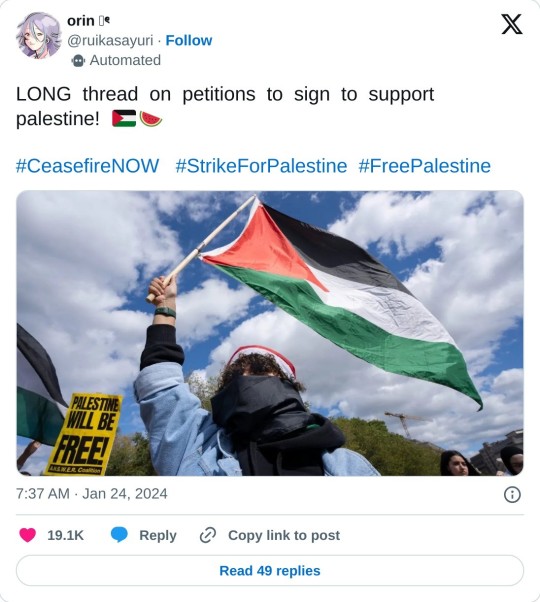
Donations: Gaza Funds | Low on Funds Palestinians Fundraisers | Vetted Gaza Evacuation Fundraisers | Arab.org Daily Click | Middle East Children's Alliance
ARMENIA
Learn for Artsakh | Help Armenians Carrd | Artsakh Genocide Action Toolkit
Info: Denying Your History - Armenian Genocide
Petitions/Letters: Petition - Stop Erasing Armenian Culture | International Recognition of Artsakh
Donations: Fund for Armenian Relief | Armenia Fund | CARITAS Armenia | ARS of Eastern USA inc.
INDIGENOUS AMERICANS
MMIWG2S | Indigenous Action | NDN Collective
Petitions/Letters: Stop sterilizing Indigenous women without consent | Free Leonard Peltier
HAWAII
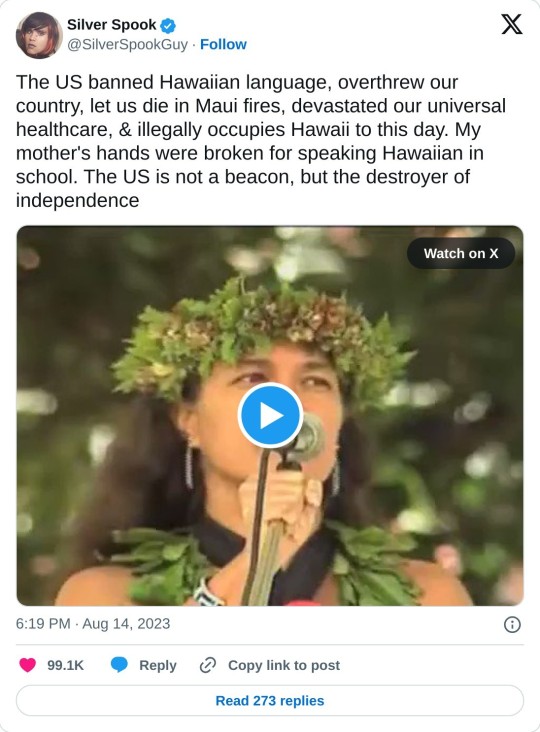
Info: Tourism's Negative Impact on Native Hawaiians | Noho Hewa Film (2008)
Donations: Hawaii Community Foundation
HAITI
Haiti Liberation Google Doc
Donations: Hands Together for Haitians | Haiti Outreach | Hope for Haiti | Twitter Thread of GoFundMes/Donation Links
WEST PAPUA
Free West Papua Website | West Papua Resources/Info Tumblr Post | We Need to Talk about Papua Carrd (last updated 2021 but has good info)
Info: United Nations - Indonesia: Shocking abuses against indigenous Papuans | Twitter Thread of Helpful Articles
Petitions/Letters:
ALSO:
The Kurdish Project
KEEP BOYCOTTING, PROTESTING, AND DOING EVERYTHING YOU CAN! FREE ALL OPPRESSED PEOPLES OF THE WORLD!
If you can't donate, share!
If you have any concerns with the links I've posted, please share! I tried my best to verify everything but please let me know if you are doubtful of something! Also, please please share other resources from people who are directly impacted by these genocides!!
LAST UPDATED SEPTEMBER 16 2024.
#stop global genocides#more resources can be found by looking up country names on my blog#please keep doing everything you can to help people in need the world needs you
52 notes
·
View notes
Text
Indian Engineers Tackle Water Shortages with Star Wars Tech in Kerala https://www.goodnewsnetwork.org/indian-engineers-tackle-water-shortages-with-star-wars-tech-in-kerala/
When a severe water shortage hit the Indian city of Kozhikode in the state of Kerala, a group of engineers turned to science fiction to keep the taps running.
Like everyone else in the city, engineering student Swapnil Shrivastav received a ration of two buckets of water a day collected from India’s arsenal of small water towers.
It was a ‘watershed’ moment for Shrivastav, who according to the BBC had won a student competition four years earlier on the subject of tackling water scarcity, and armed with a hypothetical template from the original Star Wars films, Shrivastav and two partners set to work harvesting water from the humid air.
“One element of inspiration was from Star Wars where there’s an air-to-water device. I thought why don’t we give it a try? It was more of a curiosity project,” he told the BBC.
According to ‘Wookiepedia’ a ‘moisture vaporator’ is a device used on moisture farms to capture water from a dry planet’s atmosphere, like Tatooine, where protagonist Luke Skywalker grew up.
This fictional device functions according to Star Wars lore by coaxing moisture from the air by means of refrigerated condensers, which generate low-energy ionization fields. Captured water is then pumped or gravity-directed into a storage cistern that adjusts its pH levels. Vaporators are capable of collecting 1.5 liters of water per day.
If science fiction authors could come up with the particulars of such a device, Shrivastav must have felt his had a good chance of succeeding. He and colleagues Govinda Balaji and Venkatesh Raja founded Uravu Labs, a Bangalore-based startup in 2019.
Their initial offering is a machine that converts air to water using a liquid desiccant. Absorbing moisture from the air, sunlight or renewable energy heats the desiccant to around 100°F which releases the captured moisture into a chamber where it’s condensed into drinking water.
The whole process takes 12 hours but can produce a staggering 2,000 liters, or about 500 gallons of drinking-quality water per day. Uravu has since had to adjust course due to the cost of manufacturing and running the machines—it’s just too high for civic use with current materials technology.
“We had to shift to commercial consumption applications as they were ready to pay us and it’s a sustainability driver for them,” Shrivastav explained. This pivot has so far been enough to keep the start-up afloat, and they produce water for 40 different hospitality clients.
Looking ahead, Shrivastav, Raja, and Balaji are planning to investigate whether the desiccant can be made more efficient; can it work at a lower temperature to reduce running costs, or is there another material altogether that might prove more cost-effective?
They’re also looking at running their device attached to data centers in a pilot project that would see them utilize the waste heat coming off the centers to heat the desiccant.
#good news#environmentalism#science#water#india#star wars#innovation#water is life#clean water#drinking water#inventions
41 notes
·
View notes
Text
While scrolling I suddenly saw that someone was actually claiming that "sanjay leela bhansali is not a good director".

Bhai ap ek kaam kijiye, aap mumbai jaiye jake SLB ji se baat kijiye. Aur unse kaam mangiye. Aabh aap puchenge ki kaunsa kaam. Aap unse "personal adviser" ka kaam mangiye. Aapka kaam ek ghanta bhi nahi rahega janab.

That dumbo even said that "people started glorifying jauhar" bhai apka dimag ghutno pe hai kya? Alauddin Khalji Rani Padmavati ko apaharan karne wala tha.. Since he already won the war, Rani Padmavati understood that there is no other way to survive knowing Khalji had a huge lust for girls. She didnot had the urge to get physical abuse and die in the hands of a brutal person. That is the reason why she performed "jauhar". And you are talking about glorification? lemme explain. People glorified jauhar because it was no doubt a challenging work but she was not scared. Her bravery was glorified.
Now Heeramandi, Tawaiffs are like modern day Posh Prostitutes. And Tawaiffs were prostitutes. They used to dance, sing and after that they gave sexual pleasures to those rich men. Bro they are also human being. They need love as well. Again here Tawaiffs were not glorified their emotions were glorified in the series. And the world would die if there is a crisis of Tawaiifs or Prostitutes in the world. And because of these tawaiffs India got to know about kathak and other dance forms. Gajagamini and these types of walks were actually done by Tawaiffs. They were highly cultural. Some people even took there daughters to learn dance from them. They were the most cultural people out there. Kathak and Mujra songs are famous for them.
Bro going around telling that "they have no power" I mean what type of power are you talking about? They had servants because they worked on their own. They didn't had to depend on anyone. And as mallika jaan said that, "chaand kisike banrande mein nahi ata, chaand ko doorse hi dekhna padhta hai". And girls were not wanting their lifes they were wanting this type of posh treatments my dear. Girls want to be treated like queens but they don't want to be tawaiffs. (I have huge respect for tawaiffs) No one wants to be a tawaiff they were forced to do that. And once again GIRLS WANTED THEIR POSH AND RICH LIFESTYLE NOT THEIR LIFESTYLE.

The moral of the story of Heeramandi is, we need to respect everyone in this world even the Tawaiifs and Prostitutes because if they don't exist men will die. And yes I have no shame in telling this that yes men will die.
And one more, They were ROYAL thats why ROYALTY was showcased my dear.

And yes SLB did films which were not royal but they were Royal by heart like "Black" , "Guzarish" and many more. And he has budget my friend. Everytime, he makes a come back after 4 to 5years because he choose projects which will touch the heart of every individual and he showcases Indian Cultural in his creation. That why SANJAY LEELA BHANSALI IS SANJAY LEELA BHANSALI.
"YEE SAKAL BAN, SAKAL BAN," , "GHOOMAR GHOOMAR GHOOMAR GHOOMAR GHOOME RE", "PINGA RA PORI PINGA RA PORI PINGAAA"
#kuch bhi bolne lagte log#chronology nahi samajhte#sanjay leela bhansali#heeramandi#debate#padmaavat#desiblr#desi tumblr#desi tag#desi teen#dance#fraud kiye ho tum#tumhri amma me tumko budbak banaya hai
35 notes
·
View notes
Text

Barun Sobti bagged a Filmfare for Kohrra 🎉
I am honestly so happy for him because he’s really been delivering kickass projects from Tu Hai Mera Sunday to Asur (and we all know he wasn’t quite recognized as “actor” in IPK despite giving a great performance opposite the absolutely amazing and stellar Sanaya Irani).
So I’m just happy that once again it’s been proven that Indian Television has a fab assortment of actors and the film industry needs to give them a chance - a chance outside their tiny pool of network.
Cause from SRK to Ram Kapoor - all these actors have had their humble beginnings from a small telly.
Especially when actors can perform under rigorous pressure and changing scripts - you can imagine what they can deliver in a controlled environment with a watertight script.
#Barun sobti#kohrra#filmfare#Indian television#honestly so happy for him#and really happy for what it means for itv#when will producers acknowledge itv#cause really there’s so much potential there
54 notes
·
View notes
Text
So here's something interesting...
The Beatles Derek Taylor Never-Before-Heard Collection of Lost Beatles Recordings: Including the 1967 Kenwood Sessions and John Lennon Private Recordings
This is the track listing from the description:
Tape 1: Unheard Beatles Sgt Pepper Rehearsals from Kenwood late 66 early 67
Run time is 56 minutes, songs include:
Revolution #9, mainly John in many accents, George can be heard, Paul too, Ringo one time, Terry Doran is also heard being interviewed by John, Terry Doran was ‘The Man From The Motor Trade’ on Sgt Pepper, every identical animal sound effect from Good Morning Good Morning is featured throughout, probably pre-dates Pepper and John has the sound effects saved, cockerel, hens, sheep, horse, pigs, cat, dogs etc, the very ones used on Pepper. Sitar drones almost all the way through by George, Piano backdrop also
Track Listing:
That much Control
Monte Carlo rally sound effects Terry Doran is Jack Brabham Formula 1 racer
Cat Feeding Services (Monty Python esque sketch)
A million miles away, John Indian accent Beatles far east tours in 66
Crazy banjo song, JL bellows
I’m aware of the situation monologue
Swing your partners
Lennon.McCartney complaining about the heat
John and George shouting over a very loud backing track
John/Paul counting in 123 testing, JL turns it into a poem.
Dear Prudence very early demo John wrote it way before 1968
British Police are pigs, in an Indian accent
Tape 2: George Harrison With the Bonzo Dog Doo-Dah Band and Jimmy Page.
15 tracks, 59 minutes George with his Thames Valley muso friends, Jimmy Page, Jon Lord, Joe Brown, Sam Brown, Bonzo Dog Doo-Dah band (Neil Innes, Legs Larry Smith, Vivian Stanshall) Alvin Lee, all songs written by the Bonzos and George, all recorded at FP.
Track Listing:
George into talk while playing guitar, introducing a new song
Brazil take 1 written for the Handmade films project Brazil (never went to production)
Brazil take 2
Brazil Take 3
Sooty Goes to Hawaii
Mandalay monologue for handmade films production of the same name
Sooty Goes to Hawaii #2
Sooty Goes to Hawaii #3
Operatic Aria sung by Georges father-in-law and Olivia Harrisons dad Zeke Harrison, I doubt that Olivia has heard this
Bullshot theme song for Handmade films completed production.
Hare Krishna chant by everyone
Chant 2
While my Guitar Gently weeps with Jimmy Page on guitar
Same with Alvin Lee on guitar
if I Needed Someone
Tape 3: George with Bonzo Dog Doo-Dah Band band, all co-written 25.30 mins, 16 tracks
Track Listing:
Intro Legs Larry Smith
Do You Remember
Nothing Ever Changes
Urban Spaceman
Isle of Money (I Love Money)
Can you Groove (George)
There’s a Bright Golden Boil on my Penis
I Like Cesar
Misery Farm
Julie
Danda
When You Gotta Poop
Now You’re Asleep
Telling me The End
Viv Has Gone to Heaven
Mandalay Monologue #2
Tape 4: John Interviews Yoko 1969
Recorded by John in 1969, 45 minutes, John questions Yoko’s motives for being with him, discusses very personal matters, very revealing.
Tape 5: Yoko with Dr. Artur Janov
Yoko’s Primal Scream therapy 1 hr 40 mins, of very personal therapy, Yoko discusses John, music and very personal issues including John’s friendship with George.
Tape 6: “One From The Nursery” Unreleased John Ono Lennon Album
John and Kyoko Cox Tittenhurst Park
Run time is 47 minutes
4 tracks
Lots of John talking and playing acoustic guitar (sounds like his J60E) recorded at Christmas time, Various songs stand out, all written by John & Kyoko
John, I Love You
I Wish You Were my Father.
#john lennon#paul mccartney#george harrison#ringo starr#the beatles#derek taylor#yoko ono#a lot to unpack here
94 notes
·
View notes
Text
Souriya "Spider" Prakash-Cooper


(picrew is @potato-lord-but-not's Persona Creator, moodboard by @negative-speedforce, faceclaim is Mamoudou Athie (not pictured))
Full Name: Souriya Prakash-Cooper Pronouns: he/him (cisgender omnisexual man)
Nicknames: Spider (usual nickname), bandar (from his mom, slang term meaning "monkey" or a mischievous child) Pet Names: ??? (how do you have pet names when nobody's allowed to speak?)
Relevant Tags: #oc spider, #souriya prakash-cooper
Birthday: June 20th, 1994 Age in Chapter One: 25 (about to be 26)
Universe/Fandom: A Quiet Place, specifically Day One
Physical Traits: 6'1", with the build of a speed climber (athletic, wiry but with muscle in his shoulders, quads, and especially forearms). He has particularly large hands and a long wingspan, traits that aided his success in climbing. Of Lao, Indian, and Black American descent, he has an oval-shaped face with heavily-lidded black eyes, a wide flat nose, thick but expressive eyebrows, and a crooked smile with moderately full lips. His hair is naturally a very dark brown and between a 3B and 3C hair type, though he frequently dyes it a bright cardinal-red. It is styled as an undercut, with the top reaching down to his shoulders, though he ties it into a bun or a tight braid when he climbs. He has earlobe piercings in both ears, along with an industrial in his right ear and a septum ring in his nose.
Character Traits: Highly observant and detail-oriented, good at pattern recognition, but also a confident social butterfly who thrives around others. He's charismatic and funny, if a little eccentric, and has no problem making himself look the fool for the sake of a laugh (or for his job). He's a problem-solver by nature and good at thinking outside-the-box, though tends to struggle when said problems fall outside his skill set.
Relationships: - Family: Adhira Nanette Prakash (mother), Darius Cooper (father), Devi and Manichan "Minnie" Prakash-Cooper (sisters) - Friends: A thriving network of friends within the film business pre-apocalypse, roommates Newt and Ginger, climbing buddies "Ghost" (Jaxon), "Dart" (Sophie), and "Sparky" (DJ); post-apocalypse finds allies in Sam, Eric, Marcus (OC), and Amina (OC) - Romantic Partner: Unsure (probably Eric but I haven't sorted out the details yet-)
Additional Information: - Was born in Seattle, but moved to Los Angeles as an adult to pursue a career in foley effects - At the time of AQP:DO, he was in New York for a television project - Also was a semiprofessional speed climber, and very briefly held a world record for a 15-meter prepared climb - Regularly carries around a handheld tape recorder, and uses it to record any interesting sounds he comes across - He also tries not to tape over sounds he's already recorded (unless he absolutely has to), and has whole crates of tapes collected and labelled in his home - He understands sound extremely well and is capable of moving near-silently when he tries - a combination of his impressive body control from climbing and his innate knowledge of sound from his foley career - Has recorded the sound of the Death Angels' echolocation-clicks and uses the sound to temporarily distract them when he needs a quick escape - ^ as a whole, he chooses to imitate the creatures' noises and movements rather than attempting to remain completely silent, which is a terrifying but often effective strategy - He is a sensation-seeker and often tries to experience as many different events as he can (demolition derbies, skydiving, rage rooms, live sports and concerts, etc.) - both to collect interesting sounds and simply to enjoy the experience - His nickname, Spider, was originally given to him at his climbing gym (for his long limbs and fast, eclectic climbing style), but he later began using it in his personal life as well - ^ However, he always had himself professionally credited by his full, given name, as a credit to his parents and a refusal to Anglicanize himself for film credits - First gained his interest in foley from Bollywood films and sci-fi/horror movies, since the sound design was intriguing to him
11 notes
·
View notes